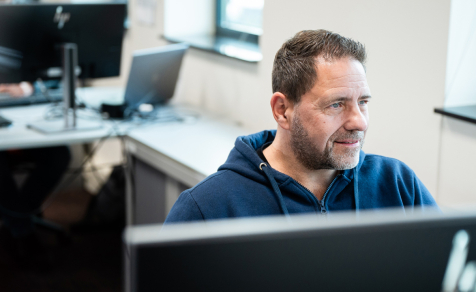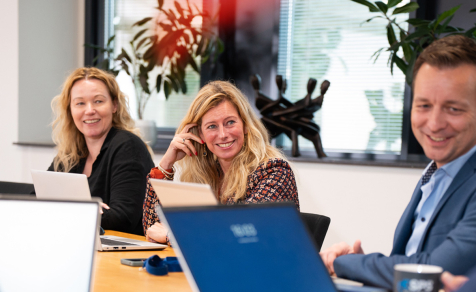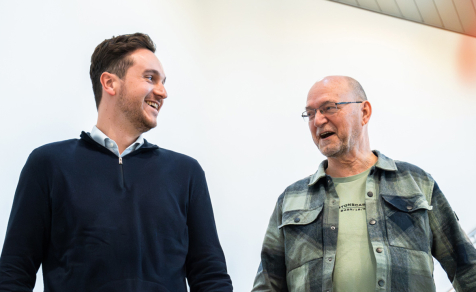As service you are the face to the customer
Building a machine is one thing, but making sure it runs trouble free for years is where IMS’s service department truly excels. Gerrit-Jan Hunting knows all about this. He started as a Service Coordinator and grew into the role of Service Manager. “The best part is that I get to build my own team and department from scratch.”
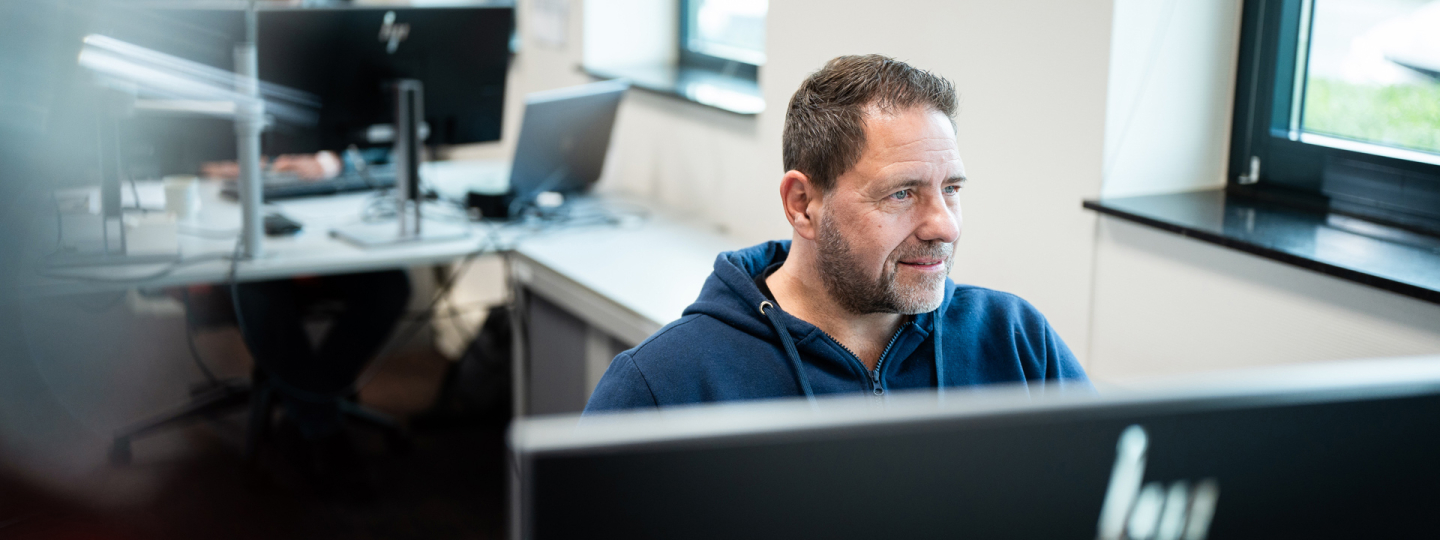
How did you end up at IMS?
“I applied to IMS for a Project Manager role. I spent many years working as a project manager in service at various companies. That gave me the chance to see a lot of the world and gain extensive experience in service. During my interview, IMS suggested I start as a Service Coordinator with the potential to grow into Service Manager. That appealed to me, and now I feel very much at home here. I’m trusted to further develop this department, which gives me a lot of energy.”
A close team with deep expertise
Gerrit-Jan works closely with Thijmen and Freddy. “There are three of us. Freddy specializes in mechanics, robotics, and software. Thijmen has all-around experience in mechatronics—covering electrical engineering, mechanics, and robotics. Both Freddy and Thijmen have extensive experience in production automation and hands-on expertise. I have a background in mechanical engineering.”
“What unites us is a practical mindset, broad technical knowledge, and a drive to truly help the customer. Because our machines are one of a kind and always custom made, the service department is regularly supported by engineers from the project team. This collaboration allows us to minimize downtime for our customers. We’re always looking for new colleagues. We have big plans and could really use extra hands.”
No nine-to-five mentality
Working in service demands flexibility. “You need to switch gears quickly and stay calm under pressure. Customers want their machines running again as soon as possible—preferably yesterday. You have to be confident, able to improvise, and stand your ground. When you walk into a room, you need to inspire confidence that you will solve the problem. And you do.”
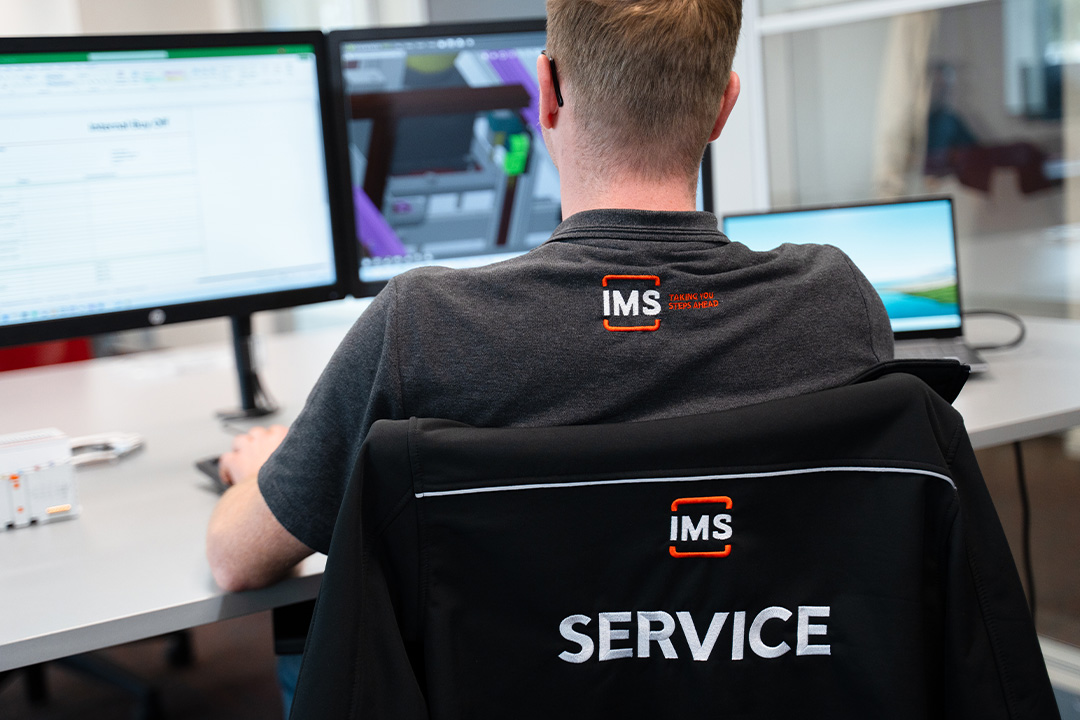
Responsible for keeping machines up and running
The service department’s mission is to keep IMS machines running. “We do this through thorough maintenance, clear maintenance plans for customers, and second-line support from IMS. We resolve many issues remotely via remote access. When necessary, we are on site anywhere in the world.”
Traveling and adapting to the situation
“Thijmen and Freddy spend about 40 to 60 percent of their time traveling. I focus more on planning, preparing quotes, and customer contact, but I’d like to join them on the floor more often. Our customers are spread around the world, so you need to enjoy traveling. Because we only build custom machines, we work closely with engineering, often brainstorming with the project team and other colleagues. There’s always something new to learn here.”
High-level customer contact
IMS works primarily for high-end clients, mostly in the medical industry. “These clients are usually technically savvy people like operators, engineers, and managers. You have to be able to communicate with all these levels. You’re advisory, solution-oriented, and service-driven all at once. If that energizes you, you’ll fit perfectly in our department.”
Building for the future
The service department is growing. “We’re expanding to provide even better support. This includes aftersales: proactively advising on maintenance, spare parts, and upgrades. Our customers understand quality comes at a cost and are willing to pay for it. If we keep surprising them with great service, that’s the perfect match.”
Why would you choose for working at Service?
“The work is dynamic, people-focused, and technically challenging. You help customers at crucial moments—when something goes wrong. You collaborate internally with every department. You have influence, you learn every day, and you make sure our machines run optimally. If you enjoy variety, responsibility, and technology, you should definitely come have a coffee with us. I’d love to give you a behind-the-scenes look.”
Excited about working at IMS?
We’re always looking for the right people to join our team. Check out our current openings and apply today.
Stories from the team
From machine concept to machine
Daniël Linschoten, Mechanical Engineer at IMS, talks about his work and the challenges it involves: “We’re focused on developing innovative solutions for complex production processes. That requires creativity, precision, and a lot of teamwork.”

Could you briefly introduce yourself?
“My name is Daniël Linschoten and I work as a Mechanical Engineer at IMS. I studied Mechanical Engineering at the University of Twente and landed at IMS through my internship. The combination of mechanical design and high-tech automation immediately caught my interest. After graduating, I was offered the opportunity to start working here. I’ve now been here for a few years and really enjoy it.”
How did you end up at IMS?
“During my Mechanical Engineering studies, I was looking for an internship. My passion for tinkering and technology brought me to IMS, where the workshop instantly grabbed my attention. What makes IMS unique is that it’s not just about theory and design. It’s about building real machines. From simulation to delivery, we handle everything from start to finish. After graduating, I knew I wanted to work in such a versatile high-tech environment. No other company offered the same blend of high tech, project diversity, and involvement from beginning to end.”
What does your work as a Mechanical Engineer look like?
“Working at IMS offers a lot of freedom. If you want to dive into simulations, there’s room for that. Want to build test setups? You can do that too. Interested in mechatronics, programming, or construction? That’s possible as well. Your preferences and ambitions really matter here.”
“No two projects are the same. Early on, you spend time brainstorming, simulating, developing concepts, and doing calculations. Then you build test setups and run tests that you translate into a robust machine design. Eventually, you’re also involved in commissioning the machine during both FAT and SAT phases.”
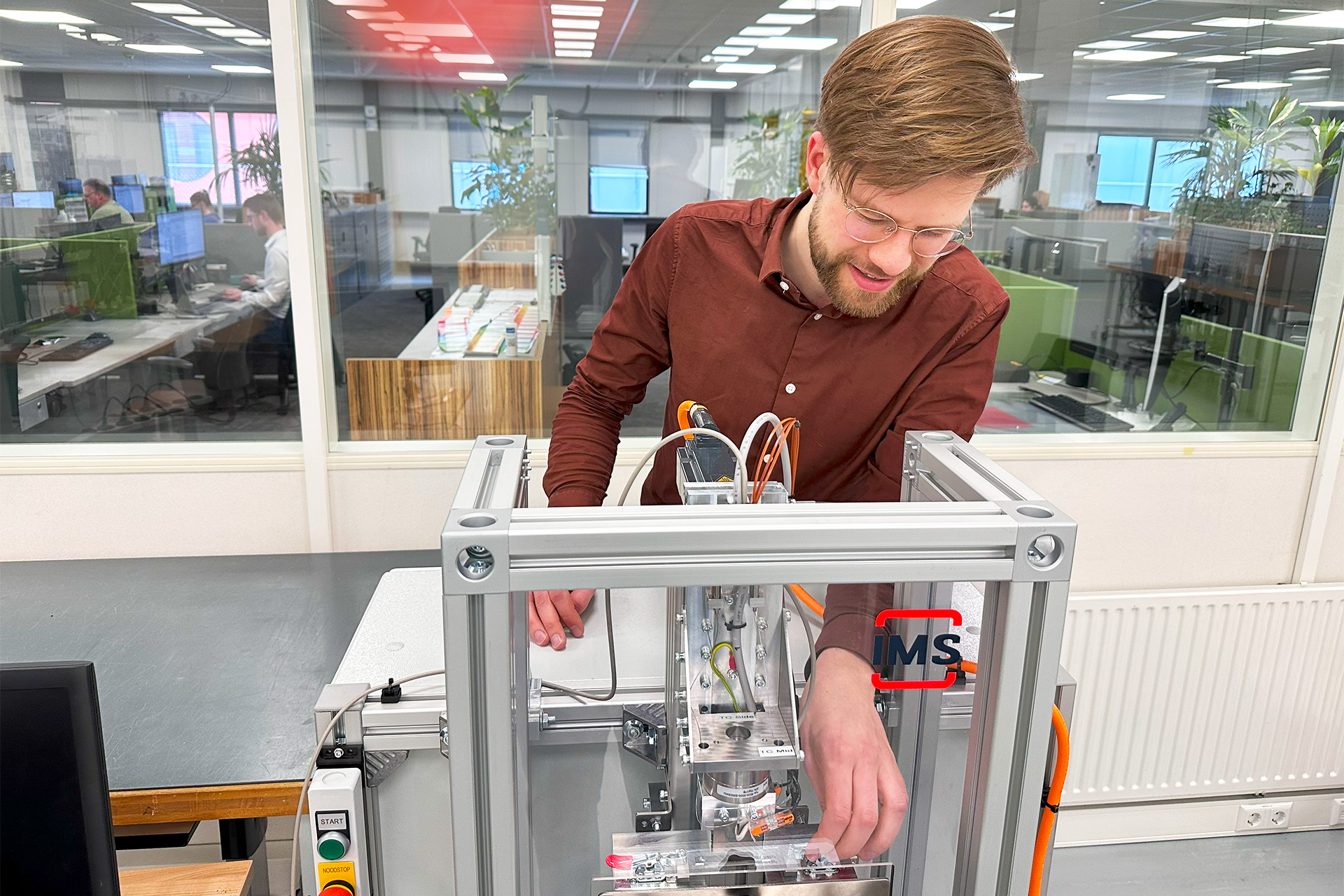
Is it easy to apply your own ideas into a project?
“You get a lot of freedom to approach your work your way. There are few more rigid rules or processes, but they still leave plenty of room for initiative and creativity. When you have a good idea, people listen. We value everyone’s input because that collaboration leads to the best solutions. Taking ownership is important. You need to be willing to take responsibility and actively contribute to the success of the team and project.”
How much do you collaborate with other departments?
“I’m in frequent contact with other Engineers and Lead Engineers to ensure that everything in a project aligns and everyone is working on the right tasks. This coordination keeps the team efficient.”
“Another key collaboration is with the System Integrators, especially when planning the machine build. They bring a lot of practical experience, which is invaluable. I also work closely with Controls Engineers to make sure the machine can be properly operated.”
How would you describe the work atmosphere at IMS?
“The atmosphere is open and collegial. We’re interested in each other’s work and help one another. At the same time, there’s a down-to-earth attitude: we’re enthusiastic about the machines we build but always practical and goal-oriented. Technology is the common thread that connects us all.”
“Outside of work, there’s room for social activities. Some colleagues I see outside of work, and our department occasionally organizes game nights or pub quizzes in the cafeteria. These activities create a great balance between work and relaxation and strengthen the team spirit.”
What knowledge or skills do you need to work at IMS?
“You need a broad technical foundation. One project might require knowledge of heat transfer, another of mechanics, dynamics, materials science, or mechatronics. Everything comes together here. Fortunately, there’s a wealth of knowledge available. In the form of extensive technical literature and from colleagues. You quickly learn who to approach with specific questions, so you’re constantly developing.”
Can you give an example of a project you’re proud of?
“Yes! I designed a very critical part of a highly complex machine. It involved complex leaf spring constructions, and I had to consider the thermal management around the component. It was challenging, but in the end, it worked exactly as intended.”
“With such a part, we can offer our clients a huge advantage in their production. The project pushed the limits of what’s even possible. When you succeed under those circumstances, it’s incredibly rewarding.”
What would you like to change at IMS?
“Sometimes projects don’t move as quickly as I’d like. Some processes take a long time, up to a year and a half before a machine is fully operational. That’s understandable given the complexity, but it means the feedback loop for solutions I develop as an engineer is slower. The shorter the project, the faster you can improve and gain new insights.”
“Occasionally, I get to develop a test setup. Those projects are fun because they move much faster. You design it, build it, and have a working setup within a month. That pace offers more variety and immediate feedback on your work, which helps your development.”
What makes working at IMS special?
“At IMS, people come from diverse backgrounds and education levels—from technical physicists to instrument makers. That mix makes our team strong. Everyone brings their own expertise, so you learn a lot from each other and complement one another well. Knowledge sharing is a big part of our culture—people gladly share their experiences and insights. That ensures you keep growing. That’s what makes working at IMS truly valuable.”
Excited about working at IMS?
We’re always looking for the right people to join our team. Check out our current openings and apply today.
Stories from the team
Where the right people make the difference
Ila Reinders, HR Manager at IMS, shares what her role is like and the kind of people IMS is built on. Because at the end of the day, it’s our people who make the difference. They bring the right mindset and consistently exceed expectations.

Can you briefly introduce yourself?
“My name is Ila Reinders and I’m the HR Manager at IMS. I studied Human Resource Management at Saxion University of Applied Sciences in Deventer, followed by a degree in Risk Management at the University of Twente.”
“My career path has been quite diverse. I spent several years working in HR at the University of Twente, and later transitioned into the corporate world to further develop myself. Since then, I’ve held HR management roles in construction, financial services, and legal consulting, before eventually finding my place at IMS.”
What makes working at IMS unique?
“IMS is a high-tech company where innovation goes hand in hand with a people-first approach. We build some of the most complex machines out there, but it’s the people who set us apart. The atmosphere in the office is informal yet professional. People are always willing to help each other out, and there’s plenty of room to take initiative. We approach challenges critically, but always with a positive mindset.”
“The people at IMS are naturally curious and solution-oriented. Our machines are always custom-built, so standard solutions usually won’t cut it. That means you often have to think beyond the obvious. And we work closely together. You’re never tackling a project on your own. You collaborate with engineers, project managers, and customers to achieve the best possible outcomes.”
What gives you the most energy in your work?
“What I love most is seeing people grow. Whether it’s watching a new hire become fully self-sufficient or seeing someone move up into a new role. It energizes me. I also really enjoy it when former employees come back to IMS. They’ve tried working at another organization, and realized that IMS simply fits better across the board. That feels incredibly rewarding.”
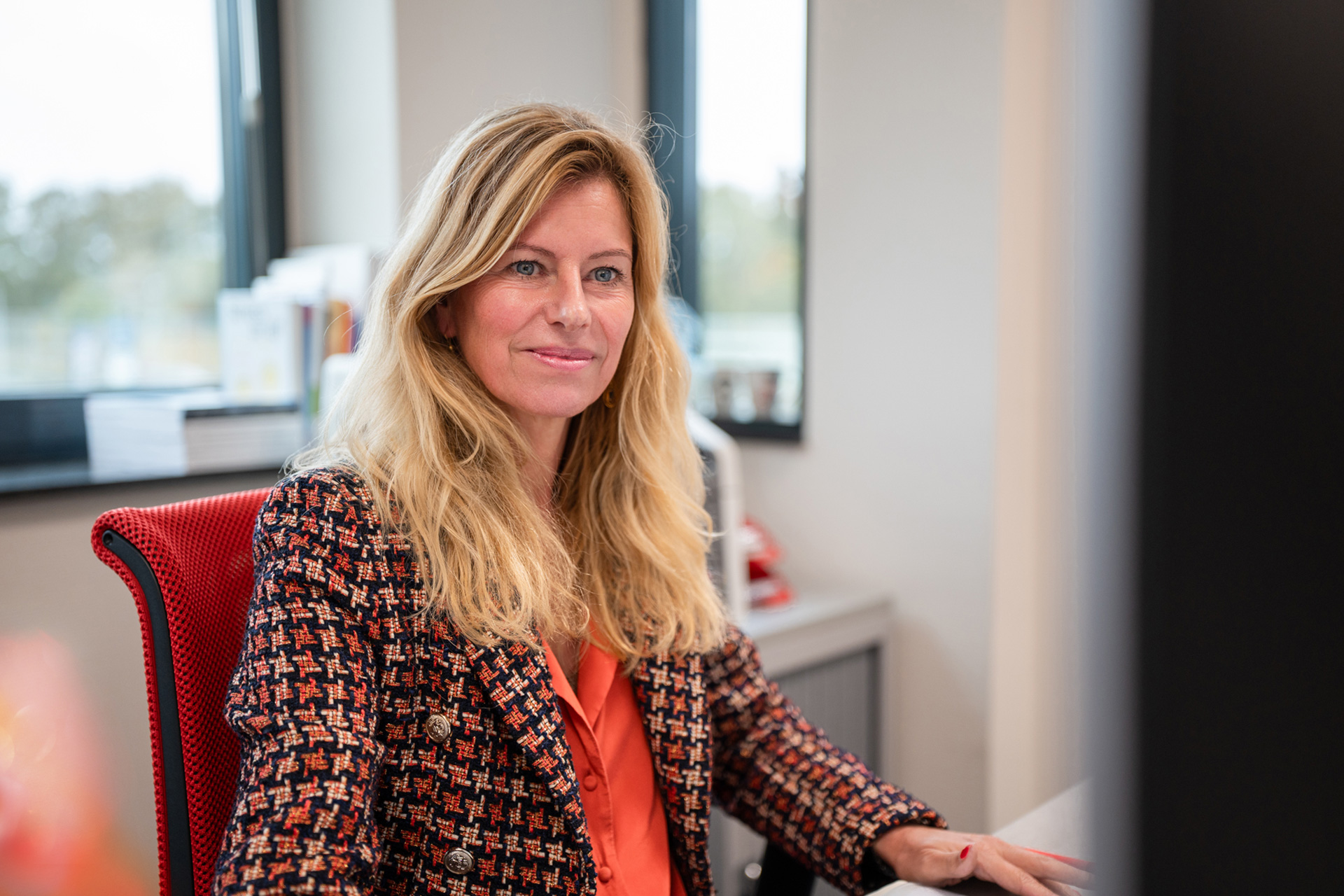
What does IMS do to support employee development?
“We strongly believe in growth. Both on a technical and personal level. New employees go through a comprehensive onboarding program, where we encourage them to really establish their place within IMS. We support people who want to specialize, but also those who want to broaden their scope. We offer training, conferences, and coaching to help them get there. We take the time to understand what someone needs, and we do everything we can to support that.”
How would you describe the company culture at IMS?
“People here are open, engaged, and forward-thinking. We’re a flat organization with an open-door policy. Everyone is encouraged to contribute their ideas. At the same time, there’s a real drive to keep improving. And we always want to take the next step in precision. That makes the work challenging, but also incredibly rewarding. And of course, there’s plenty of room for fun. Whether that’s lunch in our company restaurant or joining a sports activity after hours.”
Besides technical skills, what traits do you look for in new team members?
“We’re always looking for people who are open-minded and genuinely curious. People who make connections easily and don’t think in silos. In an interview, I always look for candidates who are authentic and enthusiastic. I really appreciate people who are just themselves. That’s what makes them interesting.”
Is there a job interview you’ll never forget?
“Oh yes, definitely! I once had a great interview with one of our former IT specialists. He seemed incredibly nervous, so I asked him about it.”
“He said, ‘I am nervous. And to be honest, I’m not a big fan of HR. You guys always ask these weird questions. You can’t prepare for them. ‘What are your strengths?’ ‘What are your weaknesses?’ I don’t really know what to say to that.”
“So I told him, ‘Well then, we won’t ask you those questions.’ And from there, we had a really great conversation. That kind of honesty and enthusiasm, we really value that here.”
What’s the best way for candidates to prepare for an interview at IMS?
“Look up who you’ll be talking to ahead of time. Check out their background, and come up with a few good questions. What do you want to know about IMS and how we work? Who will you be collaborating with the most? Write those questions down. And if you don’t get a chance to ask them during the interview, you can always call or email afterward.”
Excited about working at IMS?
We’re always looking for the right people to join our team. Check out our current openings and apply today.
Stories from the team
The freedom and responsibility at IMS keep motivating me
We value giving our employees freedom at IMS. But with that freedom also comes a great deal of responsibility. Jasper Minten, Marketer at IMS, explains how he experiences this balance in his work.
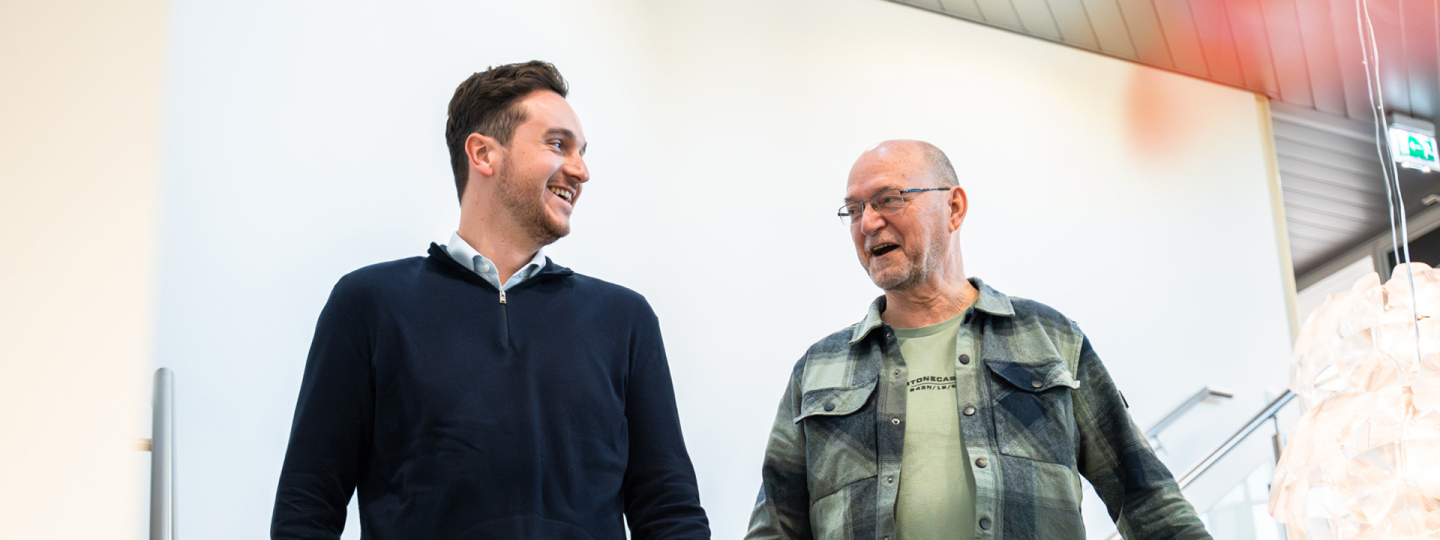
Who are you, and what do you do at IMS?
“My name is Jasper and I work as a marketer at IMS. I started my career at an agency, where I gained experience in online marketing, strategy and tactics. What really attracted me at IMS is the combination of high-tech innovation and the freedom to create impact independently. My goal is to position IMS as a known and recognized high-tech organization for production automation. The broad scope of my position gives me the opportunity to contribute both strategically and creatively. I enjoy my work a lot, and am determined to further develop myself within the company.”
Jasper, what can you tell about your role as a Marketer at IMS?
“As a marketer I am responsible for everything we communicate through our corporate channels. This means that I am both involved in regular marketing and communication activities as well as supporting Sales and HR. I work in close collaboration with the Sales team to identify potential leads and make sure we present ourselves right at customers. Even though I have a marketing background and little experience in technology, being curious gets me a long way here. At IMS you can always reach out to your colleagues to learn more about the technical side of our work. That cooperation makes my work fun, varied and challenging.”
What’s it like working at IMS?
“I find the freedom that I get here incredibly valuable. For example, I like to exercise in the morning before I start work. A fresh start of the day helps me get to work more energetic and focused. Being able to schedule my own working hours also leaves me time in the evening for other things I enjoy, such as extensively cooking.”
“What I truly appreciate is that this freedom comes with responsibility. You’re expected to get the job done, and that takes discipline. At IMS, there’s a genuine trust that you will, and that trust motivates people to take their roles seriously.”

How would you describe the company culture?
“We have an open culture, you can feel that in everything we do. Doors are always open, it’s easy to walk in and ask anyone for advice or just have a chat. We work toward our goals as a team and celebrate our successes together. At the same time, there’s plenty of room to carve your own path. That mutual trust creates a strong foundation. When things get tough, we’ve got each other’s backs. No one gets left behind; we move forward together. Besides that, IMS also places a strong emphasis on work-life balance. There’s a hybrid work policy, depending on your role, but most of us enjoy being in the office regularly.”
What makes working at IMS special to you?
“What stands out most to me is the passion and drive you see throughout the company. Whether you’re in a technical department like Mechanical Engineering or Controls Engineering, or in my team in Sales & Marketing. Everyone is committed to deliver top-notch work.”
“We specialize in complex, highly automated production lines, which call for precision and teamwork. We do not head home until everything is just right. Because we know how much that matters to our clients. That level of dedication is visible across all layers of the organization.”
Is there anything you would like to change about your job?
“As a marketer, I’d love for us to be able to showcase more of the projects we’re working on. We build production lines that are technically spectacular and solve incredibly complex challenges. Unfortunately, due to confidentiality, we can’t always share these stories externally. Which is a shame in my opinion. The work we do, may feel like routine to us, but it would be truly impressive to others. I’d like to showcase that more.”
What would you say to someone considering a career at IMS?
“IMS offers a lot of freedom, but that freedom comes with responsibility. If you’re someone who thrives on variety, teamwork and challenge, then this is a fantastic place to work. You have the flexibility to manage your own schedule, but you also need to take ownership of what you do. If you can strike that balance, you’ll definitely feel at home here.”
Does working at IMS sound exciting?
We are always in search for the right people to strengthen our team. Take a look at our current openings and apply today.
